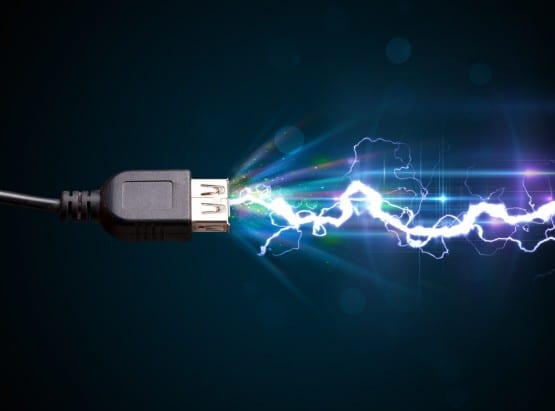When it comes to technology these days, we take things for granted mere moments after they’ve been incorporated into our lives. Brand new apps and devices offering unexpected conveniences are suddenly indispensable to daily existence. Such is the case with the USB port, used ubiquitously to transfer data and charge mobile devices.
USB devices have become so common — there’s over 10 billion of them in the world — that they’ve spawned an entire industry of weird offshoots since initially being introduced in the late 1990s. This includesa USB air-conditioned shirt, a USB posture monitor, and a vast array of quirky USB flash drives involving everything from sushi rolls to syringes. If your car doesn’t have a USB hook-up in it, it’s out of date.
But just like when you finally get comfortable with a phone an updated version is released, the USB isn’t done evolving. An article in the latestissue of The Economist says big changes are coming to USB technology in the next year or two in the form of USB Power Delivery, or USB PD.According to The Economist, from 2014, “USB cables will be able to provide power to bigger electronic devices. In the long term this could change the way homes and offices use electricity, cutting costs and improving efficiency.”
Currently USB cables support only 10 watts of direct current (DC), just enough to charge the current iteration of iPads, but USB PD will permitup to 100 watts.
The Economist argues that this could “presage a much bigger shift, reviving the cause of direct current (DC) as the preferred way to power the growing number of low-voltage devices in homes and offices.”
The global standard for electricity is alternating current (AC), promulgated by Nikola Tesla, which beat out DC for its ability to switch between different voltages and travel longer distances. However, AC power requires an adapter to power electronic equipment, which can lose valuable power during conversion (touch those black adapters and they’re warm) and run constantly, which is also wasteful.
USB co-inventor, Ajay Bhatt, who has become somewhat of a tech rock star at Intel since inventing the device to develop a universal port, said in an interview with IEEE Spectrum that USB PD, with power flowing in either direction, will allow “a power source and a computing device to negotiate power delivery mechanisms, or the voltages and the current.”
He elaborated on this idea for The Economist, saying “the computer can say ‘I need to start the hard disk now, so no charging for the next ten seconds.’”
One area where DC’s power- and cost-saving opportunities are already being realized is with large datacenters. According to Gigaom, Facebook utilized DC power in its Prineville, Oregon, data center and companies such as JPMorgan, Sprint, Boeing, and Bank of America have built DC datacenters.
According to Greentech Media, DC-powered datacenters are 20 percent more efficient than standard AC datacenters; purchase and installation cost of DC equipment is about 30 percent less; and, most significantly, DC datacenters require 25 to 40 percent less floorspace because equipment can connect directly to backup batteries.
While USB PD may offer opportunities in energy efficiency and smart grid technology, it is also poised to have a direct impact on green energy production.
DC networks work well with both solar panels and wind turbines, as both produce power at different times and in different amounts. AC grids require a constant voltage and solar and wind power must be converted via adapter to enter AC grids.
Along with the USB PD’s ability to run DC power, these two powerful changes have major implications all the way down to the household level.
According to the Energy Information Agency (EIA), the fastest growing portion of residential electricity use is consumer electronics and small appliances — which as already noted run primarily on DC power — accounting for between 15 and 30 percent of a residence’s consumption.
An article on IEEE Smart Grid notes that many of these devices have a conversion efficiency of no better than 80 percent and some low-end devices have efficiencies as low as 65 percent in converting power. These losses come from converting AC power to DC power, whichaccording to the article accounts for around five percent of all electricity used in the typical U.S. home being lost to conversion of AC to DC power to run DC devices.
In an article about this phenomenon for TheEnergyCollective.com, Jessie Jenkins asks “So if you have a solar system at your home producing DC power, why are you converting it to AC and then back to DC to run your electronics and charge your electric car? Should you be wiring up a DC circuit in your house as well to power all your DC electronics?”
With the introduction of USB PD, his question may become obsolete.
Source: Climate Progress. Reproduced with permission.










